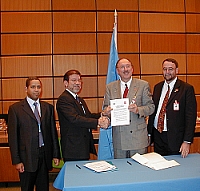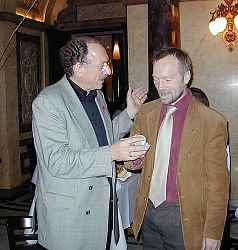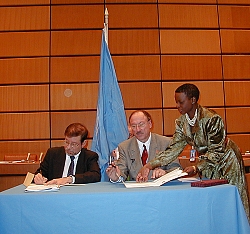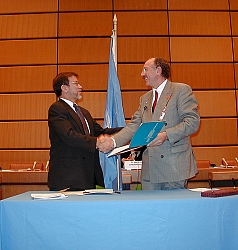The United Nations/United States of America International
Meeting on the Use and Applications of Global Navigation Satellite Systems
(GNSS)
Vienna, Austria, December 13-17, 2004
FIG signs a Memorandum of Understanding with the UN OOSA and
the President visits the Austrian Society for Surveying and Geoinformation
 Prof.
Holger Magel, President of FIG and Mr. Markku Villikka,
Director, FIG office visited Vienna, Austria 11-14 December 2004. During the
visit they met with Council members and representatives of the Austrian
Society for Surveying and Geoinformation and attended the United Nations/USA
International Meeting on the Use and Applications of Global Navigation
Satellite Systems (GNSS) at the UN Headquarters in Vienna. At this meeting a
MoU between UN OOSA and FIG was signed by Mr. Sergio Camacho-Lara,
Director of UN OOSA and President Magel. FIG had a high profile at the
meeting when Matt Higgins represented FIG at the action group and
further Dr. Naser El-Sheimy from FIG Commission 5 represented FIG at
this important event. Prof.
Holger Magel, President of FIG and Mr. Markku Villikka,
Director, FIG office visited Vienna, Austria 11-14 December 2004. During the
visit they met with Council members and representatives of the Austrian
Society for Surveying and Geoinformation and attended the United Nations/USA
International Meeting on the Use and Applications of Global Navigation
Satellite Systems (GNSS) at the UN Headquarters in Vienna. At this meeting a
MoU between UN OOSA and FIG was signed by Mr. Sergio Camacho-Lara,
Director of UN OOSA and President Magel. FIG had a high profile at the
meeting when Matt Higgins represented FIG at the action group and
further Dr. Naser El-Sheimy from FIG Commission 5 represented FIG at
this important event.
In his speech at the signing ceremony Prof. Magel mentioned:
"Firstly I would like to thank Mr. Sergio Camacho-Lara, the Director of
the UN Office for Outer Space Affairs for the invitation to be here today.
We see this Memorandum of Understanding between our two organisations as
very important. Secondly, I would also like to thank Takemi Chiku and
Cicero dos Santos from OOSA who have worked with Matt Higgins, the
Chair of FIG Commission 5 and Markku Villikka, the Director of the FIG
Office to develop this important MoU.
Ladies and Gentlemen, FIG represents about 250,000 surveyors and geodesists
working in more than 100 countries around the world. Many of those surveyors
now see GNSS as a fundamental technology that they rely on every day for
hundreds of applications. Therefore I am very pleased that FIG has been a
member of the UN Action Team on GNSS.
FIG is already working with other UN Organisations to progress some key
global issues; particularly those of significance to developing countries.
These include UN programmes on security of tenure, urban governance,
urban-rural interrelationship and sustainable development. While such issues
need to be discussed firstly at a strategic level we also know that
competence in some key technology is vital if we are to deliver solutions to
these important global problems. GNSS is one of those key technologies.
As Matt Higgins will detail on Wednesday we have already set up a Task Force
within the his FIG Commission 5 on positioning and measurements to act as a
forum for surveyors to discuss GNSS and feed policy and technical issues to
coordinating mechanisms like the International Committee on GNSS that you
will be discussing later this week.
I must say that our interest in working with OOSA extends beyond the
important technical and scientific aspects of GNSS. OOSA is also working on
the topic of disaster and natural resource management and FIG has recently
created a Working Group on that topic. That will give us a mechanism to work
with OOSA and UNEP to also progress that important topic.
FIG is also committed to capacity building in developing countries. I note
that Regional Education Centres on Space Technology are also coordinated by
OOSA. I think that FIG Commission 2 on Education can play a role (with other
FIG Commissions) to help to add to the content and depth of courses being
run in those centres.
We also need to ensure that these activities are seen more and more to be an
important part of society’s needs. FIG Commission 3 is working in the area
of Spatial Data Infrastructure and this is another mechanism for progressing
the issues covered by our MoU. The next FIG Working Week in Cairo, April
16-21, 2005, will also be joint with the 8th Conference of the Global
Spatial Data Infrastructure (GSDI) organisation and that offers an
opportunity to progress issues such as AFREF which is covered in the
recommendations of the UN Action Team on GNSS.
I should say that in all these topics we work very closely with our
so-called “Sister Associations” such as the International Association of
Geodesy and the International Cartographic Association, who have also been
very active in the UN Action Team on GNSS. I also note that another of our
“Sister Associations” the International Society of Photogrammetry and Remote
Sensing is very active in the Disaster Management work being coordinated by
OOSA.
In conclusion, my thanks again to OOSA for entering into this MoU which I am
sure will work to our mutual benefit. I wish all of you the best for the
important work you are doing here this week and I thank you for your
attention."
At the meeting with OVG, President Magel presented the FIG
President's gift to Mr. Gert Steinkellner, President of OVG and to
Mr. Gerhard Muggenhuber, Chair of FIG Commission 3 for his
contributions in the FIG Council as the representative of the ten technical
commissions in 2003-2004.

President
Holger Magel giving the President's gift to Gerhard
Muggenhuber as a token of appreciation for his contributions to FIG
as a Council member. |

President Magel and Mr.
Gert Steinkellner, President of OVG, in
the front Prof.Dr. Karl Kraus from the TU Wien. |

Mr.
Sergio Camacho_Lara, Director of UN OOSA and President Magel
signing the MoU between UN OOSA and FIG. |
 |

|

Mr. Sergio Camacho-Lara and President Magel together with
Cicero Dos
Santos from UN OOSA and Matt Higgins, FIG Commission 5, who
prepared the MoU. |
|





























